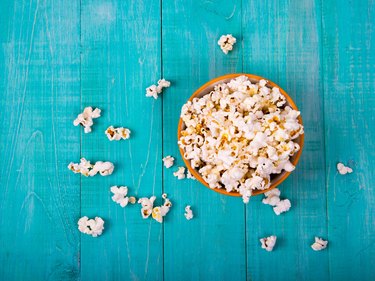
The typical ways to make popcorn are on the stove top or in the microwave. Making stove top popcorn or cooking it in the microwave both provide the fast burst of heat that popcorn needs to pop.
The oven is not the ideal tool for making popcorn. The kernels could dry out, or your popcorn could burn.
Video of the Day
Video of the Day
Tip
You can make popcorn without a microwave, but trying to make popcorn in the oven isn't a good idea.
Read more: How Healthy Is Popcorn?
What Makes Popcorn Pop?
Popcorn kernels are starch and moisture inside an airtight hull. When heat is applied to the kernel, the moisture inside the kernel turns to steam. The steam expands until it bursts through the hull, causing the kernel to pop.
Meanwhile, the heat and moisture inside the kernel turns the starch into a liquid. As the kernel pops, the starch bubbles out like soap bubbles. When it hits the air, it changes from a bubbly mass that is more liquid than solid to a solid filled with air chambers, kind of like plastic foam.
The resulting popcorn is 40 to 50 percent larger by volume than the original kernel. according to the Popcorn Board.
Bring the Heat
A kernel of popcorn needs to reach about 356 degrees Fahrenheit to pop, according to an article published in March 2015 by Journal of the Royal Society Interface. Originally, native Americans popped popcorn directly over fires or stirred it into hot sand that had been heated by a fire.
The result was a tougher popcorn than modern popcorn snackers are used to. In the early 20th century, Charles T. Manley discovered just the right combination of heat and oil needed to pop popcorn to its fluffiest. He found that oil was a better conductor of heat to the kernels than air. Oil also evened the distribution of heat, so the kernels popped before burning on one side.
The Role of Moisture
A specific level of moisture is essential in popping corn. The optimal moisture content of popcorn is 13.5 percent, according to the Popcorn Board. Commercial popcorn makers use ovens to dry the moisture content of corn at the time of picking — which is typically 20 to 25 percent — to the ideal moisture content.
They then vacuum seal the popcorn into jars or seal it in airtight bags to keep the moisture content from changing before the popcorn is popped.
Popcorn in the Oven
The problem with making popcorn in the oven is that the hot air of the oven doesn't heat the kernel effectively. Air, in general, doesn't transmit heat efficiently like oil, and the still air of an oven is not the intense stream of hot air used by a hot air popper.
In the oven, a kernel would take more time to heat up to popping temperature. While the kernel is heating, it is also drying out. It also might burn because you cannot shake the kettle with the oven door close.
Read more: Popcorn Nutrition Facts
If you want an alternative to microwave popcorn, try making stove top popcorn, as explained by Utah State University Cooperative Extension:
- Heat a skillet on the stove top.
- Add 1/4 cup of oil and heat to 400 to 460 degrees Fahrenheit.
- Drop in one or two kernels. When these pop, add enough kernels to cover the bottom of the pan.
- Pop and enjoy.